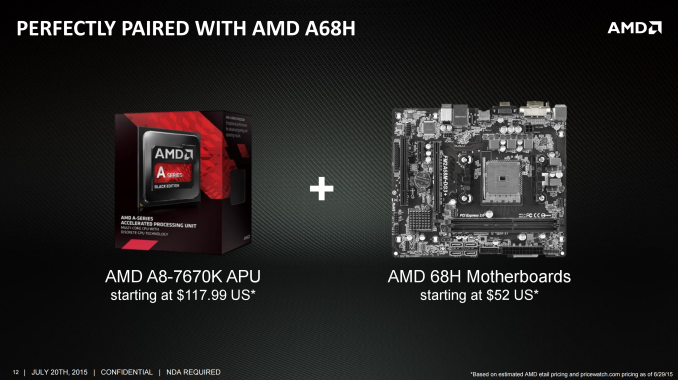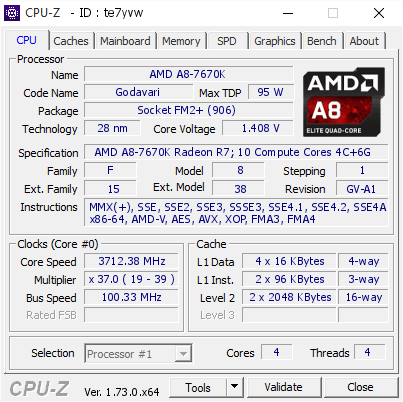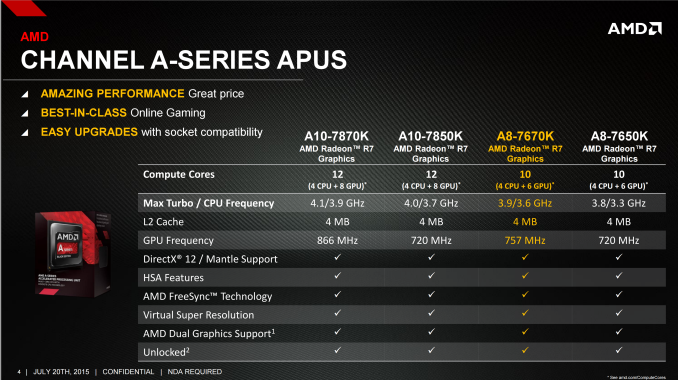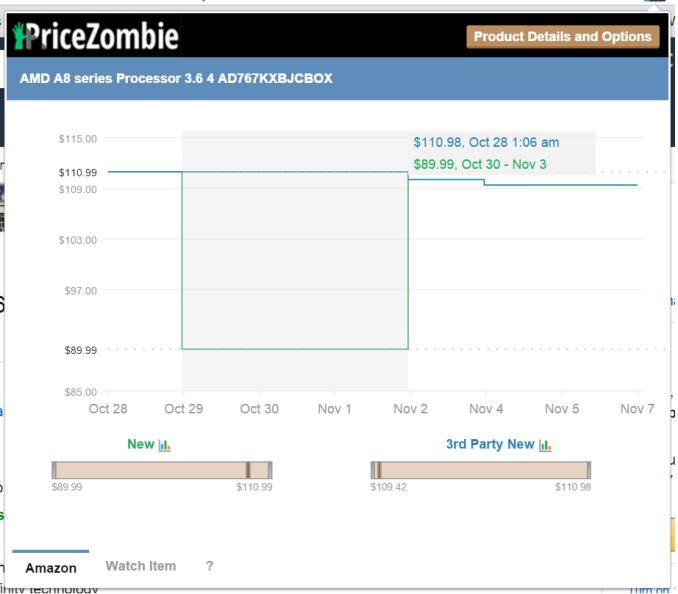The AMD A8-7670K APU Review: Aiming for Rocket League
by Ian Cutress on November 18, 2015 8:00 AM EST
Over the past couple of years, AMD has slowly released their mainstream brand of Kaveri processors. In turn, we have reviewed them, and they consistently aim to provide a midrange integrated gaming option, especially for those on a budget. The recent release of the A8-7670K was perhaps not that exciting, as AMD is filling up their product stack with new parts, taking advantage of an improved manufacturing process and aggressive binning. To that end, we're taking a different tack with this review. Alongside the regular tests, we also corralled Rocket League (an amazingly simple yet popular take on car football/soccer that sits on the precipice of e-sports glory) into a benchmark aimed at those sub-$600 gaming systems.
The AMD A8-7670K
Earlier this year, AMD announced their new line of Kaveri Refresh processors, starting with the A10-7870K (which we reviewed here). As the name suggests, these are Kaveri processors at their core, still based on the combination of Steamroller processor cores and 2nd generation Graphics Core Next (GCN) microarchitecture for graphics. These new refresh models are designed to take advantage of minor improvements in manufacturing, resulting in the ability to get higher clock speed for the same power consumption, even 18 months after the first Kaveri processors hit the scene. As a result, these Refresh processors — or, to use AMD's internal code name, "Godavari" — fill in the blank spots in the product stack and supersede the older parts, with the aim of squeezing in more frequency and performance for the same power consumption. It sounds deceptively simple — improve your process, refresh the part at the same price, and reap the benefits.
If we look at AMD's current lineup, we see that this new A8-7670K surpasses the older A10-7700K on the specification sheet, and comes in cheaper when brand-new.
| AMD Kaveri Lineup | ||||||||
| A10- 7870K |
A10- 7850K |
A10- 7800 |
A10- 7700K |
A8- 7670K |
A8- 7650K |
A8- 7600 |
X4 860K |
|
| Price | $137 | $134 | $131 | $120 | $118 | $104 | $89 | $85 |
| Modules | 2 | 2 | 2 | 2 | 2 | 2 | 2 | 2 |
| Threads | 4 | 4 | 4 | 4 | 4 | 4 | 4 | 4 |
| Core Freq. (GHz) | 3.9-4.1 | 3.7-4.0 | 3.5-3.9 | 3.4-3.8 | 3.6-3.9 | 3.3-3.8 | 3.1-3.8 | 3.7-4.0 |
| Compute Units | 4+8 | 4+8 | 4+8 | 4+6 | 4+6 | 4+6 | 4+6 | 4+0 |
| Streaming Processors |
512 | 512 | 512 | 384 | 384 | 384 | 384 | N/A |
| IGP Freq. (MHz) | 866 | 720 | 720 | 720 | 754 | 720 | 720 | N/A |
| TDP | 95W | 95W | 65W | 95W | 95W | 95W | 65W | 95W |
| DRAM Frequency |
2133 | 2133 | 2133 | 2133 | 2133 | 2133 | 2133 | 1866 |
| L2 Cache | 2x2MB | 2x2MB | 2x2MB | 2x2MB | 2x2MB | 2x2MB | 2x2MB | 2x2MB |
As it stands, the A8-7670K is a dual-module 3.6 GHz base frequency processor with a boost frequency up to 3.9 GHz. It comes with six graphics compute units, which translates to 384 streaming processors, similar to other A8 parts, but at a slightly higher IGP frequency of 754 MHz. The combined increase in processor and integrated graphics frequencies come at no extra cost in thermal design, with the A8-7670K at the same 95W TDP.
One of AMD's marketing strategies with these ~$100 processors is the price/performance angle. Aside from the integrated graphics, each of the AMD processors can pair with an R7 240 or R7 250 graphics card (DDR3 or GDDR5; AMD suggests an R7 250 GDDR5, as you might expect) in a hybrid dual graphics scenario, boosting performance. Thus, for the same price as an APU and an R7 250 graphics card, on average, AMD aims to offer a better gaming experience — especially for games that run at around 60 frames per second on medium settings — than a similarly priced Intel + NVIDIA platform. We've seen this marketing spiel corroborated in previous reviews, and would expect not to see anything different here. At launch, AMD put a $118 price on the A8-7670K, which, in recent sales, has been pushed down to under $100 at times.
The A8-7670K is an FM2+ socket processor, and thus requires either an A88X, A85X, A78 or A68 motherboard to go with it in order to take full advantage. As part of the launch, and given that this processor is a slightly boosted A8-7650K, AMD sees value in pairing it with something like a $50 A68H motherboard, making an APU+MB combination around $150 when on sale. However, as one might imagine, due to the age of the FM2/FM2+ socket, there are relatively few "new" motherboards on the market. The last one we reviewed was MSI's A88X-G45 Gaming, which brought over some of the components seen on its new Intel gaming motherboards, but other manufacturers have also put out M.2 capable AMD chipset-based motherboards as well.













154 Comments
View All Comments
BrokenCrayons - Thursday, November 19, 2015 - link
I'd love to see better IGPs from Intel as well, but it really only serves to move the bottom rung of the graphics ladder up a notch. They don't seem like they'll ever really catch up with system requirements on contemporary games. It's more of a matter of waiting for the current Intel graphics processor to be good enough to run what's already been on the market for a while in terms of entertainment. Beyond that, if Intel dedicates more space to graphics, there'll invariably be someone else who complains that it's a complete waste for there to even be integrated graphics in the first place since they have a discrete GPU.raikoh05 - Thursday, November 19, 2015 - link
you can probably make it run better https://www.youtube.com/watch?v=uiCCKurW9TUplonk420 - Thursday, November 19, 2015 - link
how the hell is this doing better than an A10 with 128 more streaming processors?JoeMonco - Friday, November 20, 2015 - link
It's summed up as "LOL AMD".Rexolaboy - Thursday, December 10, 2015 - link
The a10 benchmarks are from the launch tests. Not current, there is no reason to include them. Anandtech fail.Tunrip - Friday, November 20, 2015 - link
"I outfitted my 15-year-old cousin-in-law with an APU" THE FUTURE IS HERE! :Dhmmmmmmmmmm - Friday, November 20, 2015 - link
People spending so much time on what-ifs. Why don't they just wait for the benchmarks for Zen and Kaby Lake instead of giving each other lessons in history and mathematics.BMNify - Saturday, November 21, 2015 - link
There is an incredible bias, but to no fault of your own, in the web benchmarks part. Considering that Intel is tied for second (with Opera. Samsung is the largest, of all companies) as the most active contributor for Chromium since about 2012, major effort is being invested by Intel to optimize Chrome for their chips. It just doesn't make logical sense every Intel chip performs that much better than AMD on web benchmarks other than they have invested a lot of time in helping advance chromium development. I mean come on, even a low end Pentium at stock speeds destroys even the highest AMD chip on those javascript/Web benchmarks. That has to be obvious bias.http://mo.github.io/assets/git-source-metrics-chro...
I am not knocking Intel as their efforts are commendable in chromium development and any Chrome users who also use heavy JS browser apps would be amiss to choose AMD, but just wanted to point out that in benchmarking (which should be as level field as possible), you guys should switch to another browser like Firefox or even IE 11/Edge.
hojnikb - Saturday, November 21, 2015 - link
Edge uses the same engine as Chrome... IE11 is old.If AMD actually invested something in software optimization wouldn't hurt.
Gigaplex - Monday, November 23, 2015 - link
Edge does not use the same engine as Chrome. Edge uses EdgeHTML and Chakra, Chrome uses Blink/WebKit and V8.